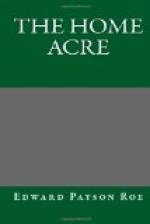All the fruits may be set out both in the spring and the fall seasons; but in our latitude and northward, I should prefer early spring for strawberries and peaches.
By this time we may suppose that the owner of the acre has matured his plans, and marked out the spaces designed for the lawn, garden, fruit trees, vines, etc. Fruit trees, like shade trees, are not the growth of a summer. Therefore there is natural eagerness to have them in the ground as soon as possible, and they can usually be ordered from the same nursery, and at the same time with the ornamental stock. I shall speak first of apples, pears, and cherries, and I have been at some pains to secure the opinions of eminent horticulturists as to the best selections of these fruits for the home table, not for market. When there is a surplus, however, there will be no difficulty in disposing of the fine varieties named.
The Hon. Marshall P. Wilder, the veteran President of the American Pomological Society, writes as follows: “Herewith is the selection I have made for family use; but I could put in as many more in some of the classes which are just as desirable, or nearly so. These have been made with reference to covering the seasons. Apples—Red Astrakhan, Porter, Gravenstein, Rhode Island Greening, Baldwin, Roxbury Russet, and Sweet Bough for baking. Pears— Clapp’s Favorite (to be gathered August 20), Bartlett, Seckel, Sheldon, Beurre Bosc, Buerre d’Anjou, and Vicar of Winkfield for baking, etc. Cherries—Black Eagle, Black Tartarian, Downer, Windsor, Cumberland, and Red Jacket.”
Mr. Wilder’s honored name, like that of the late Charles Downing, is inseparably linked with American fruits, and the country owes these two men a debt of gratitude which never can be paid for their lifelong and intelligent efforts to guide the people wisely in the choice and culture of the very best varieties. A moment’s thought will convince the reader that I am not giving too much space to this matter of selection. We are now dealing with questions which wide and varied experience can best answer. Men who give their lives to the cultivation and observation of fruits in all their myriad varieties acquire a knowledge which is almost invaluable. We cannot afford to put out trees, to give them good culture, and wait for years, only to learn that all our care has been bestowed on inferior or second-rate varieties. Life is too brief. We all feel that the best is good enough for us; and the best usually costs no more in money or time than do less desirable varieties. Therefore I seek to give on this important question of choice the opinions of some of the highest authorities in the land.




